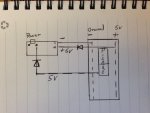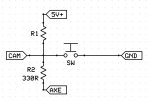Here we go again - trying to improve my Game camera project some more. I would imagine there is a better way than using a reed relay to simulate pushing a button.
any thoughts on the subject would be welcome.
Currently I open up whatever I am hacking and wire to both sides of the push button switch. Add in a reed relay and boom it works just fine.
If I meter the switch, I see voltage. While the button is push it will go to 0v, then back positive on release of the button. normal for most setups.
So how is the best way to active the switch from the picaxe chip?
Thanks.
any thoughts on the subject would be welcome.
Currently I open up whatever I am hacking and wire to both sides of the push button switch. Add in a reed relay and boom it works just fine.
If I meter the switch, I see voltage. While the button is push it will go to 0v, then back positive on release of the button. normal for most setups.
So how is the best way to active the switch from the picaxe chip?
Thanks.



